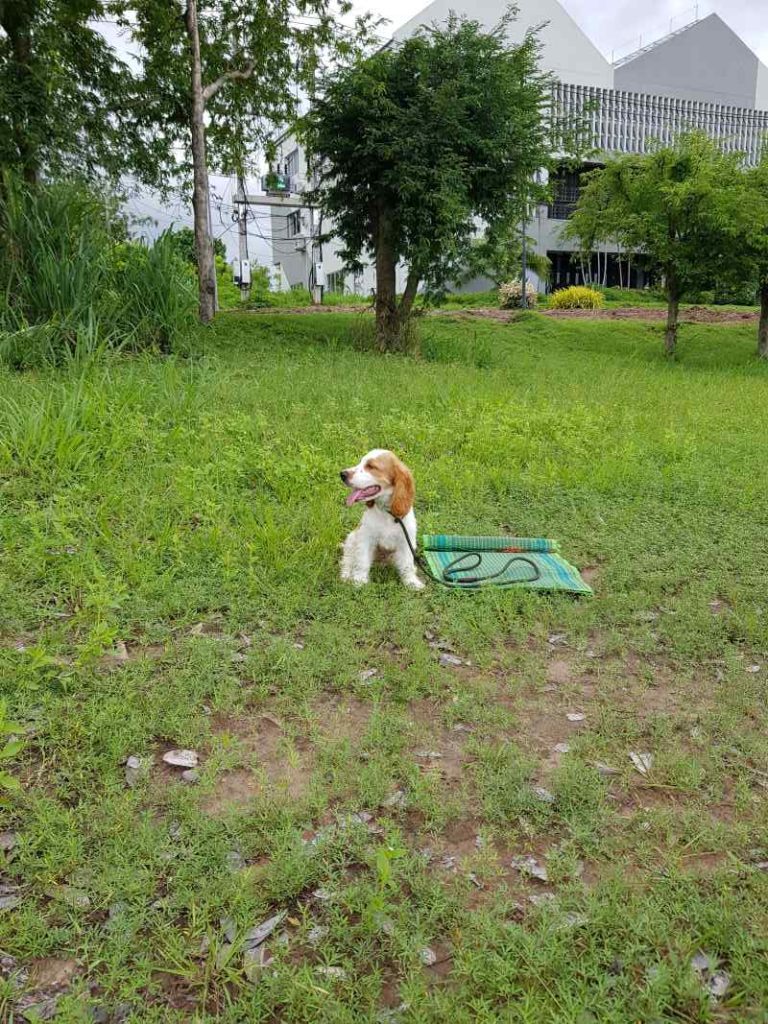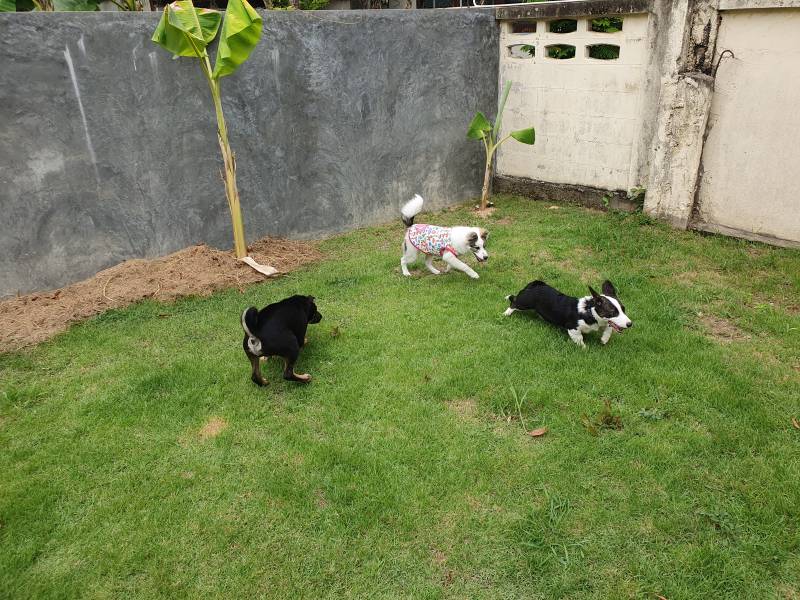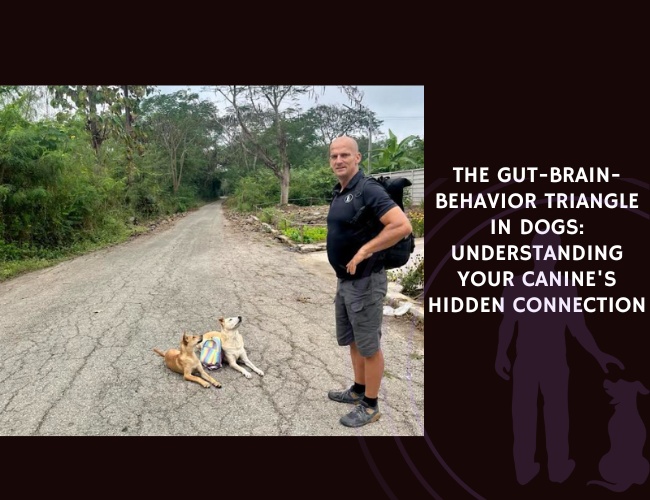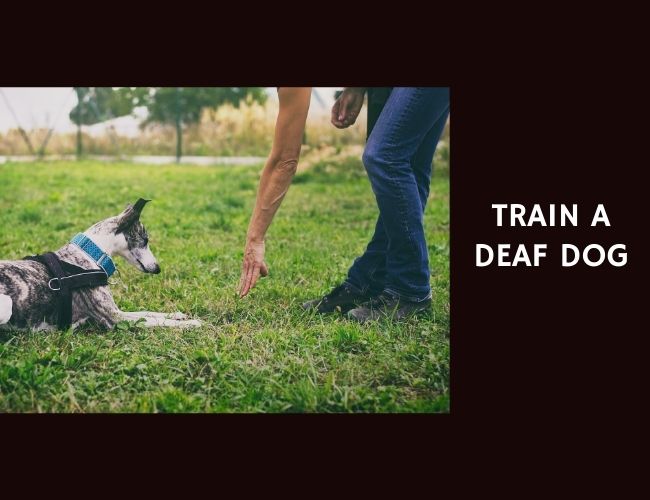Introduction
Picture this: You’re at the dog park, and your furry friend immediately approaches another dog, heading straight for their rear end with enthusiastic determination. While this behavior might make us humans blush or quickly apologize to the other owner, this fascinating ritual is actually one of the most sophisticated forms of communication in the animal kingdom. Did you know that when your dog sniffs another dog’s behind, they’re essentially reading a complex chemical biography that reveals everything from identity to emotional state?
This seemingly awkward greeting is rooted in millions of years of evolution, serving as a crucial social tool that helps our canine companions navigate their world. Far from being just a quirky habit, rear-end sniffing represents a remarkable biological system that allows dogs to gather and process information in ways we’re only beginning to understand. Let us guide you through the fascinating science behind this behavior, helping you appreciate the incredible sensory world your dog experiences every single day.
The Biological Symphony: How Dogs Process Scent Information
Understanding Your Dog’s Chemical Communication System
When your dog approaches another canine for that characteristic sniff, they’re engaging a biological system so sophisticated it puts our most advanced technology to shame. The foundation of this remarkable ability lies in specialized glands called anal sacs, located on either side of your dog’s anus. These small but mighty organs produce a unique cocktail of chemical compounds that function like a personal signature – no two dogs smell exactly alike.
The anal sac secretions contain:
- Short-chain fatty acids that vary between individuals
- Volatile organic compounds produced by symbiotic bacteria
- Specialized proteins related to odorant binding
- Pheromonal signals that convey reproductive information
You might notice that your dog’s interest in these scents seems almost obsessive, and there’s a good reason for this intensity. These chemical messages are processed through not one, but two distinct olfactory systems working in perfect harmony. The main olfactory epithelium (MOE) handles general scent processing, while the vomeronasal organ (VNO) – sometimes called Jacobson’s organ – specializes in detecting pheromones and other chemical signals that directly influence behavior and physiology.
The Vomeronasal Organ: Your Dog’s Secret Superpower
Think of the vomeronasal organ as your dog’s chemical decoder ring. Located in the nasal cavity, this specialized sensory organ connects directly to the brain regions responsible for processing emotional and hormonal responses. When your dog performs that characteristic pause during sniffing – sometimes accompanied by a slight lip curl or open mouth – they’re actually directing scent molecules to this remarkable organ for detailed analysis.
The VNO operates unconsciously, meaning your dog isn’t actively deciding to process these signals – it happens automatically, like breathing or blinking. This innate sensory system can detect chemical messages that are completely imperceptible to humans, providing dogs with a rich layer of information about their environment and the individuals within it. Recent research has even revealed that the main olfactory system and VNO work together more closely than previously thought, creating a comprehensive scent-processing network that’s truly extraordinary. 🧠
Decoding the Message: What Information Dogs Actually Gather
Individual Identity – The Genetic Fingerprint
Every dog carries a unique chemical signature that’s as distinctive as a human fingerprint. When your Labrador sniffs that Golden Retriever at the park, they’re not just saying hello – they’re reading a complex chemical profile that identifies that specific individual. This scent signature remains remarkably stable over time, allowing dogs to recognize friends they haven’t seen in months or even years.
The individual scent profile reveals:
- Genetic markers unique to that dog
- Familial relationships (dogs can recognize relatives)
- Previous encounters and shared experiences
- Individual metabolic characteristics
This ability to identify individuals through scent explains why your dog might react differently to various dogs at first meeting. They’re not being randomly selective – they’re processing chemical information that tells them whether this is truly a stranger or perhaps a dog they’ve encountered before, even briefly.
Reproductive Status and Hormonal Communication
One of the most crucial pieces of information transmitted through rear-end sniffing relates to reproductive status. Female dogs in heat produce specific pheromones that male dogs can detect from considerable distances. But the information exchange goes far beyond simple “available or not” signals.
Through chemical analysis, dogs can determine:
- The exact stage of a female’s reproductive cycle
- Testosterone levels in males (indicating dominance or breeding fitness)
- Pregnancy status in females
- Recent mating activity
- Overall reproductive health
You might notice male dogs becoming particularly interested in certain females, even when those females aren’t visibly in heat. This heightened interest often reflects the detection of subtle hormonal changes that precede visible signs of estrus. The precision of this chemical communication system ensures successful reproduction while minimizing unnecessary conflict over mates. 🐾
Health Status and Emotional Well-being
Perhaps one of the most remarkable aspects of canine chemical communication is the ability to detect health and emotional states through scent. When your dog thoroughly investigates another dog’s rear end, they’re conducting a health assessment that would impress any veterinarian.
Dogs can detect:
- Stress hormones indicating anxiety or fear
- Metabolic changes suggesting illness
- Dietary information and nutritional status
- Inflammatory markers from infections or injuries
- Emotional states like excitement, aggression, or contentment
This explains why dogs often show particular gentleness toward sick or elderly dogs – they can literally smell the difference. Your dog’s ability to detect these subtle chemical changes also explains their seemingly mysterious ability to sense when their human companions are unwell or emotionally distressed.
Social Hierarchy and Pack Dynamics
In the complex social world of dogs, establishing and maintaining social order is crucial for group harmony. Chemical signals play a vital role in communicating social status without the need for physical confrontation. When dogs meet, the information exchanged through rear-end sniffing helps establish the social dynamic almost instantly.
Social information conveyed includes:
- Confidence levels and assertiveness
- Previous social interactions and outcomes
- Pack or family group membership
- Territorial boundaries and claims
- Willingness to engage in play or mating
This chemical conversation helps dogs navigate social situations smoothly, reducing the likelihood of serious conflicts. You might notice that after the initial sniffing ritual, dogs often settle into comfortable interaction patterns – this isn’t random but rather the result of successful chemical communication establishing mutual understanding.

The Evolutionary Advantage: Why This Behavior Persisted
From Wolves to Wags: The Ancestral Connection
Your domestic dog’s rear-end sniffing behavior is a direct inheritance from their wolf ancestors. Wolves, like all wild canids, rely heavily on chemical communication for survival. This behavior has been so crucial to canine success that it has persisted through thousands of years of domestication, remaining virtually unchanged despite dramatic alterations in other aspects of dog behavior and physiology.
In wolf packs, chemical communication serves essential functions:
- Coordinating pack hunting strategies
- Synchronizing reproductive cycles within the pack
- Maintaining territorial boundaries
- Identifying pack members versus strangers
- Communicating across vast distances
Interestingly, research shows that while domestication has enhanced dogs’ ability to communicate with humans, it may have slightly reduced their overall olfactory capacity compared to wolves. Despite this, the fundamental importance of chemical communication remains paramount in your dog’s daily life.
Conflict Resolution Without Confrontation
One of the most significant evolutionary advantages of rear-end sniffing is its role in preventing unnecessary aggression. By exchanging detailed information before any physical interaction, dogs can assess whether another individual poses a threat, offers mating opportunities, or might become a playmate. This pre-emptive information gathering is incredibly efficient from an evolutionary perspective.
The conflict-avoidance benefits include:
- Reducing energy expenditure on unnecessary fights
- Minimizing injury risk from physical confrontations
- Establishing clear social boundaries quickly
- Identifying potential allies versus competitors
- Determining resource-sharing possibilities
This sophisticated system of chemical communication allows dogs to live in complex social groups with minimal conflict – a remarkable achievement that has contributed to their success as both wild and domestic animals. When you see your dog carefully sniffing another dog before deciding whether to play or walk away, you’re witnessing millions of years of evolutionary refinement in action. 😄
Reproductive Success Through Chemical Signaling
The ability to accurately assess reproductive status through scent has been crucial for canine reproductive success throughout evolution. This sophisticated system ensures that mating efforts are directed efficiently, maximizing the chances of successful reproduction while minimizing wasted energy on unreceptive partners.
Female dogs can communicate their exact reproductive status through chemical signals that change throughout their cycle. Males can detect these changes from considerable distances, allowing them to time their approach perfectly. This system is so refined that experienced males can even assess the quality of potential mates through scent alone, choosing partners most likely to produce healthy offspring.
Comparing Canine Communication Across Species
Wild Relatives: Wolves, Coyotes, and Foxes
While your domestic dog shares this sniffing behavior with their wild relatives, there are fascinating variations in how different canid species utilize chemical communication. Wolves, the direct ancestors of dogs, possess an even more developed olfactory system, with research suggesting they have greater cellularity in key brain regions dedicated to scent processing.
Comparing chemical communication across canids:
- Wolves: Use scent marking extensively for territory maintenance, with dominant breeding pairs producing distinct chemical signatures
- Coyotes: Possess well-developed scent glands and show similar sniffing behaviors but tend to be more solitary
- Red foxes: Utilize chemical signals for both territorial marking and mate selection, with unique seasonal variations
- Domestic dogs: Retain the core behaviors but show more variation due to selective breeding
Interestingly, wolves can distinguish between dog and wolf scents, spending significantly more time investigating unfamiliar wolf scents compared to dog scents. This suggests that despite their close relationship, the chemical signatures of dogs and wolves have diverged enough to be readily distinguishable.
Beyond Canines: Chemical Communication in Other Mammals
The use of anal gland secretions for communication isn’t unique to dogs – it’s widespread among carnivores and many other mammals. Understanding how other species use similar systems helps us appreciate the sophistication of your dog’s abilities.
Cats, for instance, also possess anal sacs that produce individually unique chemical signatures. Like dogs, cats use these secretions for individual recognition, with profiles that remain stable over time. However, cats tend to be more subtle in their sniffing behaviors, often investigating scent marks rather than engaging in direct rear-end sniffing.
Other mammals using similar systems:
- Hyenas: Use elaborate scent-marking rituals with anal gland secretions for clan identification
- Ferrets: Possess highly developed vomeronasal organs for pheromone detection
- Bears: Combine visual and chemical signals for communication over large territories
- Mustelids (weasels, badgers): Produce particularly pungent secretions for defense and communication
The Balance of Senses: Why Dogs Prioritize Smell
While humans are primarily visual creatures, dogs experience the world through a fundamentally different sensory hierarchy. Your dog’s world is painted in scents rather than colors, with olfactory information taking precedence over visual cues in most situations.
To put this in perspective, dogs possess up to 300 million olfactory receptors compared to our mere 6 million. The portion of your dog’s brain devoted to analyzing smells is proportionally 40 times greater than ours. This means that while you might notice another dog’s size, color, or body language first, your dog is immediately processing a rich tapestry of chemical information that tells a much more detailed story.
This olfactory primacy explains many behaviors that might seem puzzling to us:
- Why dogs can seem to “ignore” obvious visual cues
- Their ability to track scents that are days or weeks old
- Their insistence on thoroughly investigating certain spots during walks
- Their uncanny ability to detect changes in human health or emotions
Curious. Chemical. Connected.
Scent speaks volumes. Rear-end sniffing is not rude but refined, revealing identity, emotion, and health through complex chemical cues invisible to humans.
Biology drives behaviour. Anal sacs release unique compounds decoded by dual olfactory systems, including the vomeronasal organ, giving dogs a sensory superpower.



Connection comes through scent. Each sniff builds recognition and trust, allowing dogs to map relationships and navigate social worlds with instinctive precision.
When Sniffing Signals Something More
Excessive Sniffing: Understanding Anxiety and Stress
While rear-end sniffing is completely normal, excessive or compulsive sniffing can indicate underlying anxiety or stress in your dog. If you notice your furry friend engaging in prolonged or repetitive sniffing behaviors, it might be their way of coping with an overwhelming situation.
Signs that sniffing has become a stress response:
- Inability to disengage from sniffing despite redirection attempts
- Sniffing accompanied by other stress signals (panting, pacing, whining)
- Obsessive sniffing of the same dog or area
- Sniffing that prevents normal social interaction or play
Anxious dogs might use excessive sniffing as a displacement behavior – a way to avoid direct interaction while still gathering information. This can be particularly common in dogs who are:
- Under-socialized or inexperienced with other dogs
- Recovering from traumatic experiences
- Dealing with changes in their environment or routine
- Experiencing health issues that affect their confidence
If you notice these patterns, gentle redirection and positive reinforcement for appropriate greetings can help. Creating positive associations with normal sniffing durations through treats and praise can gradually normalize the behavior. Remember, your calm energy during these interactions helps your dog feel more secure. 🧡
Avoidance Behaviors: When Dogs Don’t Want to Sniff
Just as concerning as excessive sniffing is when dogs actively avoid this normal greeting behavior. A dog who consistently refuses to engage in rear-end sniffing or won’t allow others to sniff them might be experiencing:
Potential causes of sniffing avoidance:
- Fear or trauma from previous negative interactions
- Pain or discomfort in the anal region
- Extreme anxiety or defensive aggression
- Lack of proper socialization during critical developmental periods
- Medical conditions affecting the anal glands
You might notice your dog tucking their tail tightly, spinning away from approaching dogs, or even showing defensive behaviors like growling when another dog attempts to sniff. This avoidance can lead to social difficulties, as other dogs may interpret the refusal to engage in normal greeting rituals as hostile or abnormal.
Medical Concerns: When Anal Glands Affect Communication
Anal gland problems are surprisingly common in domestic dogs and can significantly impact their ability to communicate chemically with other dogs. When these glands become impacted, infected, or diseased, they can’t produce normal secretions, potentially leading to social misunderstandings.
Common anal gland issues include:
- Impaction (blocked glands unable to express naturally)
- Infection (bacterial overgrowth causing inflammation)
- Abscesses (painful, swollen glands requiring medical attention)
- Tumors (rare but serious, altering gland function)
Signs your dog might have anal gland issues:
- Excessive licking or biting at the rear end
- “Scooting” behavior (dragging their bottom on the ground)
- Unusual odor even after bathing
- Swelling or redness around the anus
- Difficulty defecating or signs of pain
When anal glands aren’t functioning properly, the altered scent profile can confuse other dogs. They might react with unusual interest, avoidance, or even aggression toward a dog whose scent doesn’t “read” normally. Regular veterinary check-ups and proper gland maintenance can prevent these communication breakdowns.
Breed-Specific Variations in Sniffing Behavior
Not all dogs approach rear-end sniffing with equal enthusiasm or technique. Selective breeding for specific traits has created interesting variations in how different breeds engage with this behavior. Understanding your breed’s tendencies can help you better interpret their social interactions.
Scent hounds (Beagles, Bloodhounds, Basset Hounds) often display:
- Prolonged, methodical sniffing sessions
- Greater interest in scent trails than direct sniffing
- Ability to distinguish more subtle chemical differences
- Tendency to vocalize when detecting interesting scents
Sight hounds (Greyhounds, Whippets, Afghan Hounds) typically show:
- Briefer, more perfunctory sniffing greetings
- Greater reliance on visual cues for initial assessment
- Less persistence in following scent trails
- Quicker transition from sniffing to other interactions
Working breeds (German Shepherds, Belgian Malinois, Dutch Shepherds) often exhibit:
- Efficient, purposeful sniffing behavior
- Quick assessment followed by decision-making
- Higher alertness to unusual or threatening scents
- Integration of scent information with other sensory inputs
Toy breeds (Chihuahuas, Yorkshire Terriers, Pomeranians) frequently display:
- Cautious approach to sniffing larger dogs
- Preference for sniffing at scent marks rather than direct contact
- Heightened sensitivity to chemical signals indicating size or threat
- Compensatory behaviors like increased vocalization

Practical Applications: Living with a Sniffing Dog
Supporting Healthy Sniffing Behaviors
As a responsible dog owner, understanding and supporting your dog’s natural sniffing behaviors is crucial for their mental and social well-being. Rather than feeling embarrassed or trying to prevent this behavior, you can help facilitate healthy chemical communication between dogs.
Tips for supporting appropriate sniffing:
- Allow adequate time for greeting rituals (typically 3-10 seconds)
- Stay calm and relaxed during dog-to-dog introductions
- Avoid pulling your dog away mid-sniff unless necessary
- Reward polite sniffing behavior with praise
- Recognize when sniffing has served its purpose and encourage play or walking
Remember that rushing these interactions or showing anxiety yourself can create negative associations with this natural behavior. Your dog picks up on your emotional state, so maintaining a confident, relaxed demeanor helps them feel secure during social interactions.
Managing Sniffing in Public Spaces
While rear-end sniffing is natural and necessary, there are times when you’ll need to manage this behavior appropriately. Not every dog or owner is comfortable with extended sniffing sessions, and some situations require more controlled interactions.
Strategies for public sniffing management:
- Master the “let’s go” or “enough” command for gentle redirection
- Practice controlled greetings with familiar dogs first
- Use positive reinforcement for appropriate sniffing duration
- Recognize signs that another dog is uncomfortable
- Respect other owners’ boundaries and preferences
It’s important to distinguish between normal sniffing that should be allowed and situations where intervention is appropriate. If either dog shows signs of stress, aggression, or extreme discomfort, it’s time to calmly redirect the interaction. Teaching your dog to respond to gentle redirection ensures they can gather necessary social information while maintaining appropriate boundaries.
Enhancing Your Dog’s Olfactory Environment
Since smell is so crucial to your dog’s understanding of the world, providing opportunities for olfactory enrichment can significantly improve their quality of life. This goes beyond just allowing rear-end sniffing – it’s about creating a rich sensory environment that engages their primary sense.
Olfactory enrichment activities:
- “Sniff walks” where your dog sets the pace and investigates freely
- Scent games using hidden treats or toys
- Rotating toys to maintain novel scents
- Allowing investigation of safe, interesting objects from outside
- Creating scent gardens with dog-safe plants
These activities not only provide mental stimulation but can also reduce anxiety and problem behaviors. A dog who has adequate opportunities to use their nose is generally calmer, more confident, and better adjusted socially. Think of it as providing your dog with their daily “newspaper” of neighborhood news! 🐾
The Human Perspective: What We Can Learn
Respecting Canine Communication Methods
As humans sharing our lives with dogs, it’s essential to respect their natural communication methods, even when they seem foreign or embarrassing to us. Your dog’s need to sniff other dogs’ rear ends is as fundamental as our need to see faces and read expressions. Attempting to prevent or punish this behavior can create confusion and anxiety in your dog.
Understanding the sophistication and importance of chemical communication helps us appreciate the rich sensory world our dogs inhabit. When we respect their need to gather information through scent, we’re acknowledging their nature and supporting their emotional well-being. This respect strengthens the human-canine bond and helps our dogs feel understood and accepted.
Building Better Human-Dog Relationships
Recognizing the importance of olfactory communication can transform how we interact with our dogs. By understanding that they’re constantly processing chemical information we can’t perceive, we become more patient with behaviors like extended sniffing during walks or careful investigation of new items brought into the home.
Ways to incorporate this understanding:
- Allow extra time for walks to accommodate sniffing needs
- Recognize that your dog can smell your emotional state
- Understand that changes in routine or health affect your scent
- Appreciate your dog’s ability to detect subtle environmental changes
- Use scent-based activities to deepen your bond
When you respect your dog’s olfactory needs, you’re communicating that you understand and value their perspective. This mutual respect forms the foundation of a truly harmonious relationship between species with very different sensory experiences.
Conclusion: Embracing the Sniff
As we’ve explored throughout this comprehensive guide, rear-end sniffing is far more than a quirky canine behavior – it’s a sophisticated biological system that has evolved over millions of years to facilitate complex social communication. From the intricate chemistry of anal sac secretions to the remarkable processing power of the vomeronasal organ, every aspect of this behavior serves crucial functions in your dog’s daily life.
Understanding why dogs sniff rear ends helps us appreciate the incredible sensory world they inhabit – one painted in scents rather than sights, where chemical messages convey stories we can barely imagine. This behavior allows dogs to identify individuals, assess health and emotional states, determine reproductive status, and establish social hierarchies, all within a few seconds of focused sniffing.
The next time you’re at the dog park and witness this ritual, remember that you’re observing one of nature’s most elegant communication systems in action. Your dog isn’t being rude or embarrassing – they’re engaging in a complex exchange of information that helps them navigate their social world safely and successfully.
By respecting and supporting this natural behavior, we strengthen our bonds with our canine companions and help them maintain their emotional and social well-being. Whether it’s allowing adequate sniffing time during walks, managing greetings appropriately, or providing olfactory enrichment at home, our understanding and acceptance of this behavior enriches both their lives and ours.
So embrace the sniff! Celebrate your dog’s incredible ability to read the chemical stories written by every dog they meet. In doing so, you’re not just accepting a behavior – you’re honoring millions of years of evolution and the remarkable sensory abilities that make dogs such extraordinary companions. After all, in a world full of fascinating scents and chemical conversations, your dog is fluently speaking a language we’re only beginning to understand. 🧡
Is understanding your dog’s sniffing behavior helping you build a stronger relationship? Remember, every sniff is a sentence in your dog’s daily dialogue with the world around them.










